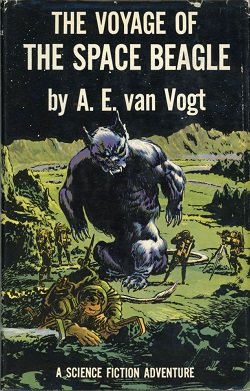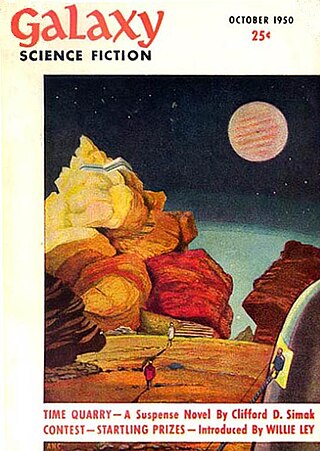
Astrobiology is a scientific field within the life and environmental sciences that studies the origins, early evolution, distribution, and future of life in the universe by investigating its deterministic conditions and contingent events. As a discipline, astrobiology is founded on the premise that life may exist beyond Earth.

Extraterrestrial life or alien life is life which does not originate from Earth. No extraterrestrial life has yet been conclusively detected. Such life might range from simple forms such as prokaryotes to intelligent beings, possibly bringing forth civilizations that might be far more advanced than humanity. The Drake equation speculates about the existence of sapient life elsewhere in the universe. The science of extraterrestrial life is known as astrobiology.

Space exploration is the use of astronomy and space technology to explore outer space. While the exploration of space is currently carried out mainly by astronomers with telescopes, its physical exploration is conducted both by uncrewed robotic space probes and human spaceflight. Space exploration, like its classical form astronomy, is one of the main sources for space science.

Planetshine is the dim illumination, by sunlight reflected from a planet, of all or part of the otherwise dark side of any moon orbiting the body. Planetlight is the diffuse reflection of sunlight from a planet, whose albedo can be measured.
The extraterrestrial hypothesis (ETH) proposes that some unidentified flying objects (UFOs) are best explained as being physical spacecraft occupied by extraterrestrial intelligence or non-human aliens, or non-occupied alien probes from other planets visiting Earth.

The Voyage of the Space Beagle (1950) is a science fiction novel by Canadian-American writer A. E. van Vogt. An example of space opera subgenre, the novel is a "fix-up" compilation of four previously published stories:
Xenoarchaeology, a branch of xenology dealing with extraterrestrial cultures, is a hypothetical form of archaeology that exists mainly in works of science fiction. The field is concerned with the study of the material remains to reconstruct and interpret past life-ways of alien civilizations. Xenoarchaeology is not currently practiced by mainstream archaeologists due to the current lack of any material for the discipline to study.
Wayne Douglas Barlowe is an American science fiction and fantasy writer, painter, and concept artist. Barlowe's work focuses on esoteric landscapes and creatures such as citizens of hell and alien worlds. He has painted over 300 books, magazine covers and illustrations for many major book publishers, as well as Life magazine, Time magazine, and Newsweek. His 1979 book Barlowe's Guide to Extraterrestrials was nominated in 1980 for the Hugo Award for Best Related Non-Fiction Book, the first year that award category was awarded. It also won the 1980 Locus Award for Best Art or Illustrated Book. His 1991 speculative evolution book Expedition was nominated for the 1991 Chesley Award for Artistic Achievement.

Expedition: Being an Account in Words and Artwork of the 2358 A.D. Voyage to Darwin IV is a 1990 speculative evolution and science fiction book written and illustrated by the American artist and writer Wayne Barlowe. Written as a first-person account of a 24th-century crewed expedition to the fictional exoplanet of Darwin IV, Expedition describes and discusses an imaginary extraterrestrial ecosystem as if it were real.

A Bracewell probe is a hypothetical concept for an autonomous interstellar space probe dispatched for the express purpose of communication with one or more alien civilizations. It was proposed by Ronald N. Bracewell in a 1960 paper, as an alternative to interstellar radio communication between widely separated civilizations.
Extraterrestrial is a British-American two-part television documentary miniseries, aired in 2005 in the UK by Channel 4, by the National Geographic Channel in the US on Monday, May 30, 2005 and produced by Big Wave Productions Ltd. The program focuses on the hypothetical and scientifically feasible evolution of alien life on extrasolar planets, providing model examples of two different fictional worlds, one in each of the series's two episodes.

Across the Sea of Suns is a 1984 hard science fiction novel by American writer Gregory Benford. It is the second novel in his Galactic Center Saga, and continues to follow the scientist Nigel Walmsley, who encountered an extraterrestrial machine in the previous book, In the Ocean of Night, aboard an expeditionary spacecraft, searching for life. Eventually Nigel discovers evidence of the major conflict in the galaxy.

The planetary systems of stars other than the Sun and the Solar System are a staple element in many works of the science fiction genre.
Cosmic Odyssey is a 2002 Canadian documentary television series about the cosmos, created by Avanti Pictures, narrated by William Shatner, and produced by Soapbox Entertainment for The Discovery Channel. In 2003, Schlessinger Media released the series in VHS video format. As of 2007, the series is syndicated on The Science Channel.
Natural History of an Alien, also known as Anatomy of an Alien in the US, is an early Discovery Channel pseudo-documentary similar to Alien Planet, aired in 1998. This pseudo-documentary featured various alien ecosystem projects from the Epona Project to Ringworld. It also featured many notable scientists and science fiction authors such as Dr. Jack Cohen, Derek Briggs, Christopher McKay, David Wynn-Williams, Emily Holton, Peter Cattermole, Brian Aldiss, Sil Read, Wolf Read, Edward K. Smallwood, Adega Zuidema, Steve Hanly, Kevin Warwick and Dougal Dixon.

Ancient astronauts have been addressed frequently in science fiction and horror fiction. Occurrences in the genres include:
The cultural impact of extraterrestrial contact is the corpus of changes to terrestrial science, technology, religion, politics, and ecosystems resulting from contact with an extraterrestrial civilization. This concept is closely related to the search for extraterrestrial intelligence (SETI), which attempts to locate intelligent life as opposed to analyzing the implications of contact with that life.
Speculative evolution is a subgenre of science fiction and an artistic movement focused on hypothetical scenarios in the evolution of life, and a significant form of fictional biology. It is also known as speculative biology and it is referred to as speculative zoology in regards to hypothetical animals. Works incorporating speculative evolution may have entirely conceptual species that evolve on a planet other than Earth, or they may be an alternate history focused on an alternate evolution of terrestrial life. Speculative evolution is often considered hard science fiction because of its strong connection to and basis in science, particularly biology.

Snaiad is a speculative evolution, science fiction and artistic worldbuilding project by Turkish artist C. M. Kösemen, focused on a fictional exoplanet of the same name. Begun in the early 2000s and inspired by earlier works such as Wayne Barlowe's 1990 book Expedition, Kösemen has produced hundreds of paintings and sketches of creatures of Snaiad, with detailed ecological roles and taxonomic relationships to each other. The sheer number of invented creatures and lineages makes Snaiad one of the most biologically diverse fictional worlds.

The following outline is provided as an overview of and topical guide to extraterrestrial life:











